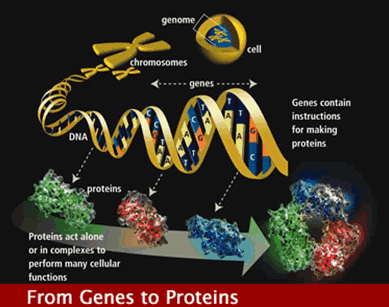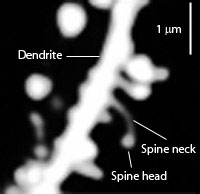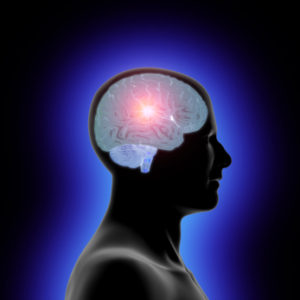 With each mental event, dramatic structural changes occur inside large numbers of neurons, outside of neurons in the extracellular space, at the synapses between neurons and in glial brain cells. Remarkably, these molecular changes occur instantaneously all over the brain in specific circuits using many different mechanisms (some have been described in previous posts). For each different momentary event, the same neuron can be used in completely different circuits. Signals in the circuits occur simultaneously with other types of electrical communication including synchronous oscillations and changes in the extracellular electrical potentials. Also, with each new learning event new cells are minted from stem cells and incorporated into the neuronal circuits. This is just part of the life of a thought in the brain.
With each mental event, dramatic structural changes occur inside large numbers of neurons, outside of neurons in the extracellular space, at the synapses between neurons and in glial brain cells. Remarkably, these molecular changes occur instantaneously all over the brain in specific circuits using many different mechanisms (some have been described in previous posts). For each different momentary event, the same neuron can be used in completely different circuits. Signals in the circuits occur simultaneously with other types of electrical communication including synchronous oscillations and changes in the extracellular electrical potentials. Also, with each new learning event new cells are minted from stem cells and incorporated into the neuronal circuits. This is just part of the life of a thought in the brain.
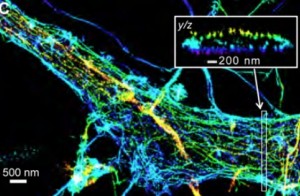 Neurons have been described in previous posts as extremely complex cells—virtual civilizations with a nucleus manufacturing products and massive microtubule transit systems with multiple complex motors transporting materials and mitochondria. Actin structural tubules rapidly build, destroy and rebuild extremely complicated scaffolding structures to support new dendrite spines and boutons at the end of axons.
Neurons have been described in previous posts as extremely complex cells—virtual civilizations with a nucleus manufacturing products and massive microtubule transit systems with multiple complex motors transporting materials and mitochondria. Actin structural tubules rapidly build, destroy and rebuild extremely complicated scaffolding structures to support new dendrite spines and boutons at the end of axons.
The relatively tiny neuron nucleus supports the massive axon, sometimes two feet long  (from spinal cord to the foot) connecting with up to 100,000 other dendrites. These synapses are built and pruned constantly in the 100 billion neurons and the trillions of synapses.
(from spinal cord to the foot) connecting with up to 100,000 other dendrites. These synapses are built and pruned constantly in the 100 billion neurons and the trillions of synapses.
The scaffolding project is immense, but meanwhile, the neuron, also, somehow analyzes and transmits information and meaning.
While every detail is not known, a recent study showed that just shifting mental attention toward or away from visual stimuli, alters synapses instantly. Changes occur in the weighting of the pre synaptic events—increasing the sensitivity in order to distinguish the focus from the noise of other sensory input.
This post is a brief overview of the massively complex events that occurs in milliseconds when a subjective mental event occurs.
Meaning Triggers Specific Neuron and Immune Proesses
As well as the neuronal changes, some mental events trigger very specific alterations throughout the body, especially in the immune system. Strangely, the meaning of the mental event determines many specifics of the molecular cascades throughout the body.
A recent study showed that pleasure that was derived from finding meaning or helping society showed major gene expression changes involving an increase in anti-inflammatory factors and increase in anti viral factors. Both of these are major drivers of many illnesses. What is very surprising is that pleasure associated with enjoying something such as a meal, or a possession did not have this effect. Therefore, the specific meaning of the mental event and thought directs thousands of different gene systems using the very complex process just elaborated.
Recently, meditation has, also, triggered specific genes related to anti-inflammatory and antiviral immune responses.
Manufacturing Starts in the Nucleus
To respond to the mental event, the neuron manufactures new material almost instantly. The motors, the tubules, and all the chemical reactions that are triggered are all dependent upon the very specific shapes of proteins. Somehow, the genetic process understands exactly what shaped molecule is needed and how to find that code. How can this occur?
The protein is manufactured from the code transmitted from the DNA to the RNA. This code is then transported to the enormous motor called the ribosome where each amino acid is affixed to the growing molecule in order by the special coding. But, this process is really enormously complex.
First the DNA must be unspooled from the large protective molecules called chromatin (unless the unspooling is blocked by epigenetic markings on the histone). Chromatin consists of many large spool-like proteins called histones. Once the spool is open, an enzyme glides along the DNA copying the code into RNA code on the messenger RNA (unless the DNA is blocked by epigenetic marks on the DNA itself). Multiple factors stimulate, inhibit, and regulate this process (perhaps as many as millions of factors)
How Does RNA Know How to Edit Itself
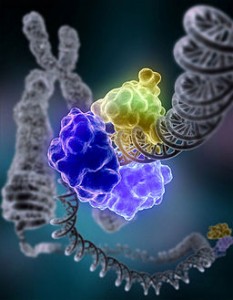 Recent research shows that only 1.5% of the human DNA in any cell is involved in coding for the proteins. This 1.5% equals approximately 20,000 “genes.” But, in fact there are many more proteins made from the code. The additional amount occurs because once the code is transferred to a strand of messenger RNA, the RNA then edits it in multiple different ways. The RNA takes code from various places, cutting out sections and rearranging sections. It cuts and pastes repeatedly. Recently it was learned that, at times, the RNA takes sections of DNA code from multiple different so-called “genes” in order to make one protein. Because code is taken multiple places, the word gene as currently used has to be redefined and it is used here in quotes. The code for specific proteins do not come only from one previously defined gene, but can come from many different places.
Recent research shows that only 1.5% of the human DNA in any cell is involved in coding for the proteins. This 1.5% equals approximately 20,000 “genes.” But, in fact there are many more proteins made from the code. The additional amount occurs because once the code is transferred to a strand of messenger RNA, the RNA then edits it in multiple different ways. The RNA takes code from various places, cutting out sections and rearranging sections. It cuts and pastes repeatedly. Recently it was learned that, at times, the RNA takes sections of DNA code from multiple different so-called “genes” in order to make one protein. Because code is taken multiple places, the word gene as currently used has to be redefined and it is used here in quotes. The code for specific proteins do not come only from one previously defined gene, but can come from many different places.
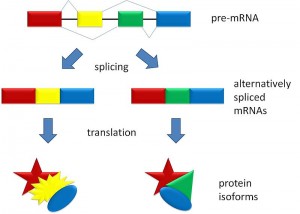 No one knows how RNA knows how to edit itself –a process known as alternative RNA splicing. But, each aspect of this process, the unspooling, the finding the specific pieces of DNA, the self-editing of RNA all need direction. It appears that some of these directions come from proteins that stimulate or inhibit DNA use. But, much more comes from the many different small and large RNA molecules that are made from the 98.5% of the DNA that is not in the so-called “genes”.
No one knows how RNA knows how to edit itself –a process known as alternative RNA splicing. But, each aspect of this process, the unspooling, the finding the specific pieces of DNA, the self-editing of RNA all need direction. It appears that some of these directions come from proteins that stimulate or inhibit DNA use. But, much more comes from the many different small and large RNA molecules that are made from the 98.5% of the DNA that is not in the so-called “genes”.
There is much debate about the 98% of DNA that are not specifically called genes. Those who believe this enormously complex intelligent editing process is entirely random consider most of it “junk.” “Junk DNA” is defined as random pieces of DNA accumulated by a messy process that either does not make RNA at all, or if it does, the RNA is useless.
However, the recent ENCODE study (a consortium of 160 international research centers over 10 years – see posts Encode 1 Mind and Molecular Genetics, Encode 2 New Genetic Landscape, and Encode 3 Encode and Evolution) showed that at least 20% of the total DNA produces small and large RNAs which serve to direct much of the process. Also, it is known that 50% of the DNA consists of virus like particles called “jumping genes,” which also might be providing some direction. (Please see other post for discussion of the place of jumping genes in evolution).
 ENCODE found 4 million different switches were active, often operating in multiple places at once; 18,000 places where active RNA is made; and 8 million different particles interacting to regulate these RNAs. Basically, ENCODE found that far from being junk, at least 20% of the DNA is made into important small and large RNA particles that have a use. This useful 20% of the DNA is 30 times the amount of DNA, which is in all the “genes”.
ENCODE found 4 million different switches were active, often operating in multiple places at once; 18,000 places where active RNA is made; and 8 million different particles interacting to regulate these RNAs. Basically, ENCODE found that far from being junk, at least 20% of the DNA is made into important small and large RNA particles that have a use. This useful 20% of the DNA is 30 times the amount of DNA, which is in all the “genes”.
Critical Shape Determined by RNA Editing
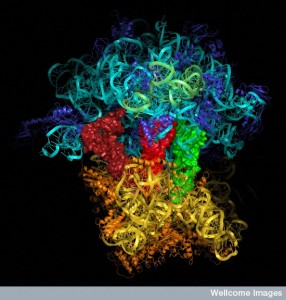 After the RNA editing, which can make as many as 500 different proteins from one supposed “gene”, the protein is built by combining amino acids end to end to make the protein. Somehow, by using the correct code the process knows the exact shape of the protein that it needs to make the alterations in the neuroplasticity processes in the neurons. The shape is the critical factor for a protein, because it operates as a machine interacting with all the other pieces. (Recently, some proteins were found to have many different shapes for different functions.)
After the RNA editing, which can make as many as 500 different proteins from one supposed “gene”, the protein is built by combining amino acids end to end to make the protein. Somehow, by using the correct code the process knows the exact shape of the protein that it needs to make the alterations in the neuroplasticity processes in the neurons. The shape is the critical factor for a protein, because it operates as a machine interacting with all the other pieces. (Recently, some proteins were found to have many different shapes for different functions.)
Remarkably, the cell knows exactly what shape it will need for the new proteins being instantly made to respond to the changes that are occurring in the neuroplastic circuits. However, currently, it is impossible for science to predict from the code what the shapes will be for even an average sized 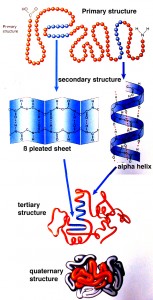 protein. In fact, if all the supercomputers on earth calculated the folding of one average sized protein (400 amino acids) it would take thousands of years to make this single calculation. 400 amino acids represents just an average sized protein, many being much more complex.
protein. In fact, if all the supercomputers on earth calculated the folding of one average sized protein (400 amino acids) it would take thousands of years to make this single calculation. 400 amino acids represents just an average sized protein, many being much more complex.
But, somehow, the cell knows what the shape will be and with the help of special chaperone molecules it folds into primary, secondary, tertiary and then quaternary folding in a millisecond. After the folding the protein is ready to take its place in the neuroplasticity events triggered by the thought.
Instantaneous Neuroplasticity Changes
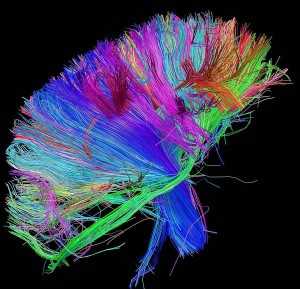 These fantastic molecular mechanisms ultimately are used in large brain wide neuronal brain circuits. Finding the mechanism at the level of brain circuits has also been extremely difficult.
These fantastic molecular mechanisms ultimately are used in large brain wide neuronal brain circuits. Finding the mechanism at the level of brain circuits has also been extremely difficult.
Recently, it has been found that most mental events are not located in a small region or hub of the brain. Observation of the brain with very slow fMRI studies (fMRI capture approximately one second) has fostered the notion that there are individual spots in the brain for each mental event. But, in fact, more accurate studies show that most events occur all over the brain in very complex networks in the realm of milliseconds, which are impossible to measure currently.
These genetic changes involving thousands and possibly millions of different factors instantly alter major structures inside cells, cell networks, and extracellular systems. Previous posts have described the details of many of the different structural changes that occur with neuroplasticity instantaneously with each mental event. There are many more being discovered daily.
The following is a very simplified list of some of the major ways that changes occur instantaneously in brain circuits. Each requires instant manufacture of many specific proteins using all of the mechanisms described above:
 Manufacture and placement of more AMPA glutamate receptors. More calcium and more AMPA receptors cause lasting increase in signal called long term potentiation.
Manufacture and placement of more AMPA glutamate receptors. More calcium and more AMPA receptors cause lasting increase in signal called long term potentiation.- The dendrites change structure, especially the size of the head of the dendrite spine increasing the ability to receive information.
 The post synaptic density made of over 1000 interlocking large complex proteins (with different composition in different places in the brain and different types of neurons) alters its structure.
The post synaptic density made of over 1000 interlocking large complex proteins (with different composition in different places in the brain and different types of neurons) alters its structure.- Change of molecules that stick out from the neuron synapse (neuroligins on post synaptic neuron shakes hands with neurexins from the presynaptic neuron)
- A surge in calcium triggers new types of “memory proteins”.
- Pre synaptic neurons substitute neurotransmitters and postsynaptic change receptors match substitution.
 Signaling cascades from the membrane to the nucleus are altered.
Signaling cascades from the membrane to the nucleus are altered.- Changes in axon ion channels alters electrical signal.
- Balance of inhibition and stimulation changes.
- New micro RNA’s alter process.
- Interneurons are altered.
- Mitochondria in the dendrite alter the strength of the signal.
- Focused attention changes synapse structure.
- Multiple different changes in climbing fibers in cerebellum.
- NMDA glutamate receptors substitute their subunits.
- Transport motors are substituted.
- Actin and microtubules direct multiple different structural changes.
- Exosomes send information from astrocytes to neurons including pieces of DNA and proteins
Many Levels of Triggers From Molecules to Society
Somehow, our mental events simultaneously trigger very complex cellular activity at all of the genetic levels mentioned above, in all the brain mechanisms listed above and in many different brain regions in milliseconds.
The stimulus for mental events comes from a wide variety of sources—sensory stimulation from the environment, reading, thinking, and interacting with people and culture. These stimuli are at vastly different sizes spanning 12 orders of magnitude. Each different type of mental event creates different impacts with different results at all of these levels.
 In fact, it is impossible to separate the levels of magnitude in human existence. Events from the quantum level and the large connections of brain regions are both involved. Recently, quantum effects have been found in living organisms: calcium signaling in the brain, chemical reactions in the cell, navigation in birds, and the efficient mechanisms of photosynthesis. It does appear that scaffolding molecules such as actin, myosin, and the microtubule operate as an intelligent LEGO machine. The structures of the scaffolding and their very complex molecules appear to be a language of the mental event in the cell. How much this is related to quantum events inside the cellular organelles and scaffolding structures remains to be discovered. How this could be triggered from a thought is completely unknown.
In fact, it is impossible to separate the levels of magnitude in human existence. Events from the quantum level and the large connections of brain regions are both involved. Recently, quantum effects have been found in living organisms: calcium signaling in the brain, chemical reactions in the cell, navigation in birds, and the efficient mechanisms of photosynthesis. It does appear that scaffolding molecules such as actin, myosin, and the microtubule operate as an intelligent LEGO machine. The structures of the scaffolding and their very complex molecules appear to be a language of the mental event in the cell. How much this is related to quantum events inside the cellular organelles and scaffolding structures remains to be discovered. How this could be triggered from a thought is completely unknown.
The life of the each thought in the brain includes a huge number of orders of magnitude at the same time. There are so many levels there is no way other than lists to describe all of the mechanisms acting at once—12 orders of magnitude are involved—all of them representing the very same event.
- Quantum effects
- Molecules, small and large
- Cellular motors
- Scaffolding structures
- Organelles
- Neurons and Glial Cells
 Networks of Neurons and glial cells
Networks of Neurons and glial cells - Brain Hubs
- Brain Regions
- Total Brain
- Interactions with Others
- Science, Society and Culture
The Life of A Thought in the Brain
Despite huge efforts of almost half a million neuroscientists in the world for many years, there is no evidence, or viable theory, of a brain center of conscious subjective experience. There is no physical brain region that represents subjective experience.
The amount of simultaneous details elaborated above makes it difficult to even develop a theory of how all of this could happen at once. One example of the massive scale involved is the fact that in the last month of pregnancy the fetus is manufacturing 250,000 new neurons every second, and these are being transported into place in the brain and integrated into circuits.
There is no way to explain these vast effects of a thought with current molecular theories, neuronal connectivity theories or brain region theories. Quantum theories are not yet adequate, although some show promise. Another theory of calcium waves, which have many important effects in the process, is also not yet adequate.
 Where is the direction for all of this activity spanning 12 orders of magnitude? Somehow, the mind as we know it, interacts on all of these levels at once. How, exactly, mental events trigger this vast array of activity still remains to be seen. But, it certainly implies that a theory of mind in all of nature might be a far better way to understand these phenomenon than the current approaches.
Where is the direction for all of this activity spanning 12 orders of magnitude? Somehow, the mind as we know it, interacts on all of these levels at once. How, exactly, mental events trigger this vast array of activity still remains to be seen. But, it certainly implies that a theory of mind in all of nature might be a far better way to understand these phenomenon than the current approaches.
